The author running the Seekins Precision Havak HIT rifle through a shooting drill. Tanner Denton
We may earn revenue from the products available on this page and participate in affiliate programs. Learn More ›
It’s no easy feat determining the best rifles of 2022, but it’s a task that the editors at Outdoor Life took on with delight as we converged at Gunsite Academy in late March. I’ve been to Gunsite countless times over the years, but never had I arrived in such style—at the wheel of a rented RV stuffed to the gills with guns, ammunition, optics, tools, targets, and the other myriad bits and pieces required to conduct this annual event.
For the first time in the gun test’s history, we took it on the road. Previously, we held the test on our home turf. For the last 12 years that meant in Montana, where I live. And prior to that, we held the test in Tennessee, where Jim Carmichel, my predecessor as Outdoor Life’s shooting editor, hails from.
But enduring winter after winter of brutal weather for the gun test had taken its toll, and we all agreed it was time to head to warmer climes. So, I pointed the RV south, and covered the 1,000 miles between Bozeman and Paulden, Arizona, hauling the largest lineup of new guns we’ve ever tested.
The Rifle Test 2022 Award Winners
- Best Hunting Rifle: Nosler 21
- Great Buy Hunting Rifle: CZ-USA 600 Alpha
- Best Precision Rifle: Accuracy International AT-X
- Great Buy and Most Innovative Precision Rifle: Seekins Precision Havak HIT
Best Rifles of 2022: A Broad Field
The rifles this year were especially diverse. We had ultralight mountain rifles, lever guns, semi-auto carbines, scout rifles, heavy-barreled precision rifles, handy deer guns, one very specialized urban sniper rifle, and plenty of hybrids designed to serve multiple roles.
So what trends, if any, can be gleaned from such a mixed lot? One thing noticeable by its absence were any bargain-basement price point guns. Of the 17 rifles that survived the test (as usual, we had some casualties that couldn’t keep up), we only had three with MSRPs under $1,000. Those included the CZ-USA 600 Alpha ($749), which took home a Great Buy award, the Franchi Momentum Elite ($899), and the CVA Cascade SB ($670). The average MSRP across the field was $2,524, an eye-catching figure even in these inflationary times.
That average was driven higher by some very expensive—though undeniably cool—niche rifles such as the Proof Tundra ($7,999), the B&T SPR300 Pro ($5,200), and the Accuracy International AT-X ($4,999), which won an Editor’s Choice award in the Precision Rifle category.
How We Test
The Outdoor Life gun testing protocol is unlike any other in the outdoor industry. No other publication goes to the lengths we do to objectively test new rifles, shotguns, and handguns. The reasons for that are many, but these are some of the major ones: the costs are enormous, you need highly-skilled and objective judges, and you have to be willing to put the interests of your readers above the desires of the gun companies.
Not to put too fine a point on it, but many of the other awards that get tossed about the industry are vetted by those publication’s advertising departments. If you’ve ever wondered why small niche companies, some of whom have put out amazing products over the years, never win those awards, it’s because they don’t have the advertising dollars to compete with the big boys, who win year after year.
But this test is different, and always has been. We pit the entries head-to-head and when the dust settles we tabulate the scores and whoever wins, wins.
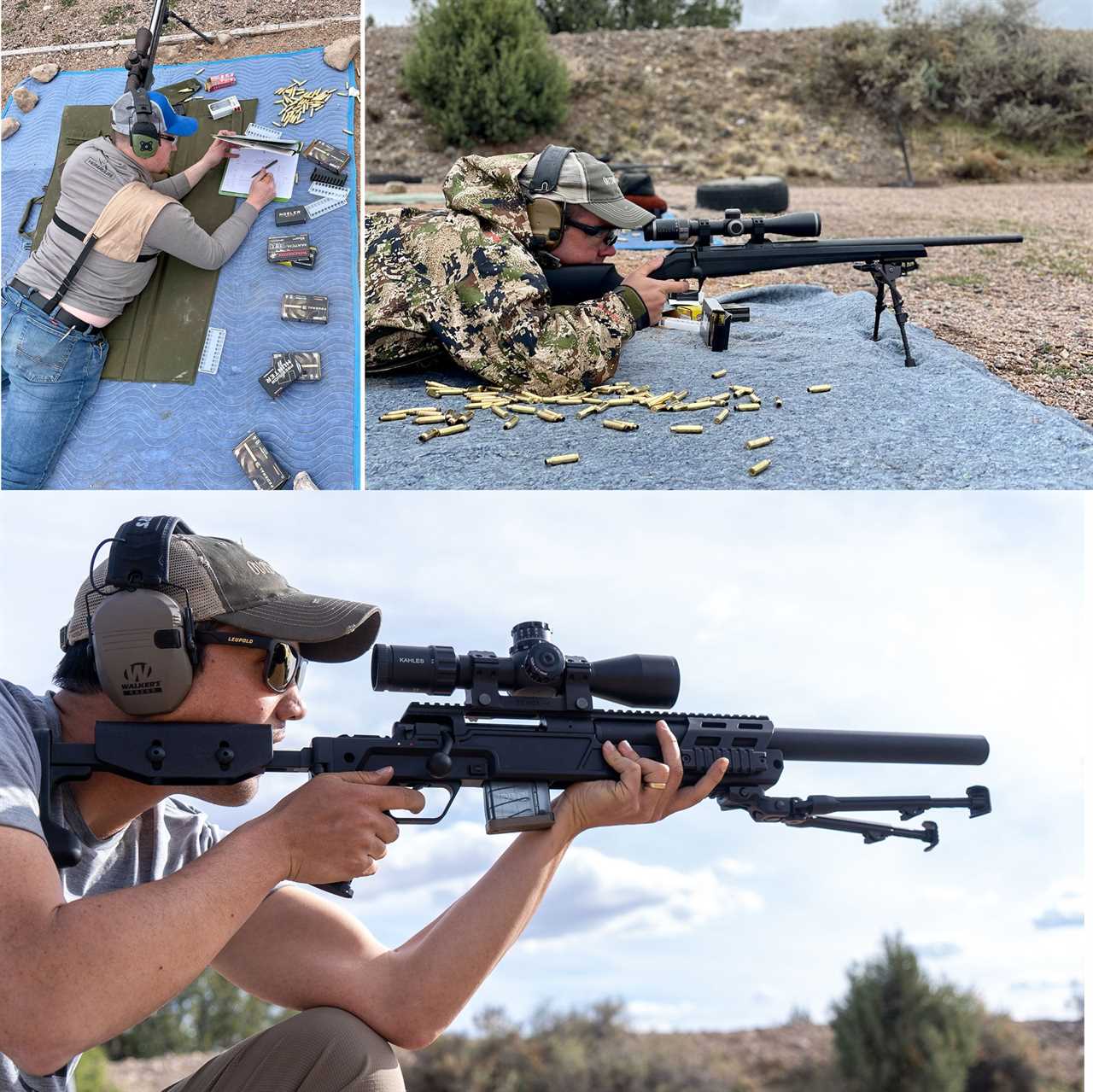
Our rifle testing includes exhaustive shooting for groups followed by running the rifles through field positions. Natalie Krebs
We shoot the hell out of each rifle for accuracy and practical field handling. We go over each with a critical eye to pick apart their construction and evaluate workmanship.
Our published accuracy results are the averages of the best ten 5-shot groups for each rifle. While it is fun to highlight some of the smallest groups in the test—and we will do that—this 10-group average is much more meaningful with respect to a rifle’s true in-the-field performance. (And, incidentally, is a much tougher standard than you’ll see in other gun tests.)
It takes a long time to gather that much accuracy data. The five shooters on the team spent two full days to shoot 374 5-shot groups for record. One reason we shoot that much is that we want each rifle to shine as brightly as possible. We shoot a variety of ammo, bullet styles and bullet weights. And in between groups we will clean the rifles if needed, and refoul them to get the most out of each. When the accuracy work was done, we ran each rifle through dynamic shooting drills from field positions.
How We Grade
Each rifle is evaluated on nine categories and given a score of 1 to 5 from each judge, except for the accuracy score, which is based on the data from the groups shot. We average the scores for each category and use that to determine the ranking and awards. The categories are handling, accuracy, workmanship, aesthetics, ergonomics, meets purpose, versatility, reliability, and value.
The scores then translate to the grades on the report cards for each firearm. Performance consists of the scores from handling, accuracy, ergonomics, and reliability. Design includes workmanship, aesthetics, meeting its purpose, and versatility. Value stands on its own.
To earn an “Excellent” rating, the average of that score must be 4.5 or higher, a difficult mark to hit. “Very Good” is an average score of 3.5 to 4.5; “Good” is from 2.5 to 3.5; “Fair” is from 1.5 to 2.5; and “Poor” is under 1.5.
Best Rifle of 2022, Hunting: Nosler 21
Report Card
- Performance: Very good
- Design: Very good
- Value: Very good
Nosler M21 Specs
- Action: Two-lug bolt
- Stock: Carbon-fiber composite
- Caliber: 6.5 CM
- Capacity: 4-round, hinged floorplate magazine
- Weight : 6 pounds 10 ounces
- Trigger: 4 pounds 4 ounces, adjustable
- Barrel: 22 inch, threaded 5/8-24
- Length: 41.25 inches
- Price: $2,295
We’ve sung the praises of Nosler’s new Model 21 over the last year, so this win wasn’t unexpected. The way it handled for me on a dangerous game hunt in Zimbabwe last year certainly left a positive impression (read our full review on the Nosler Model 21 here). That said, this win wasn’t a sure thing either. The competition among the hunting rifles this year was fierce. Strong showings by Proof, Christensen Arms, Marlin, and Weatherby kept the race neck-and-neck until the end.
The Nosler 21 delivered solid scores across the board. Its handling, workmanship, and aesthetics impressed all the judges. In a field of extremely accurate rifles, it held its own. It happened to turn in the tightest group of the test, a 5-shot .266-inch bughole with Federal’s 140-grain SMK, and averaged .885-inch groups across the board.
A couple things in particular tipped the scales in the Model 21’s favor. The quality that the test team mentioned repeatedly in their notes was the rifle’s superb balance. Not only in terms of how well the gun ran, but with respect to its design, features, and price.
The rifle’s 7-pound 4-ounce weight hits a sweet spot for a big-game hunting rifle. It’s light enough to haul over rough ground, yet has enough heft so that it manages recoil and unsupported shooting positions like a dream.

Natalie Krebs runs the Nosler 21 through field position drills. Alex Robinson
The carbon-fiber stock is stiff and has good texturing for a secure grip and the Mack Brothers Evo action ran extremely well. It fed without any issue, but a couple of testers felt that the case ejection was a bit insipid from time to time. (The Model 21 uses a single plunger-style ejector.) The rifle comes with a TriggerTech trigger that I dialed down to a 3-pound setting, and gave a crisp, consistent break.
Internally, the rifle has some great features as well, such as toolless takedown of the bolt so it can be serviced in the field, and an innovative self-indexing recoil lug design that gives the barrel extra thread engagement.
One point of irritation was the bolt handle, which kept spinning loose. A drop of thread locker would remedy that, but it should come from the factory that way.
Other than that minor issue we felt that for $2,295 the Nosler delivered a lot of performance for the money. For a solid all-around big game hunting rig, you won’t find a better rifle. And that’s exactly why it won the Outdoor Life Editors’ Choice award for 2022.
Best Rifle of 2022, Precision: Accuracy International AT-X
Report Card
- Performance: Excellent
- Design: Very good
- Value: Good
Accuracy International AT-X Specs
- Action: Six-lug bolt (two rows of three)
- Stock: Aluminum chassis
- Caliber: 6.5 CM
- Capacity: 10-round AI AW magazine
- Weight : 13 ounds
- Trigger: 10.4 ounces, adjustable
- Barrel: 24 inch, threaded 5/8-24
- Length: 42.75 inches
- Price: $4,995
Accuracy International threw down the gauntlet when they introduced the AT-X last year. They wanted to put all the makers of rifles for long-range competition on notice. AI, as you might know, makes some of the best sniper rifles in the world and their historic focus has always been on military and law enforcement.
Despite the expense of their rifles and the fact that they are built with the battlefield in mind, rather than shooting matches, a devoted number of civilian shooters have used their rifles in competition, including myself. For me and these other shooters the exceptional accuracy and ruggedness of AI’s rifles makes up for some of the competition-specific features the rifles have lacked.
Well, we don’t have to compromise anymore. The AT-X is AI’s first purpose-built competition rifle, and it has a number of design elements that shooters in field-style matches, like the NRL, PRS, and RTC, will find appealing.
The fore-end has a flat bottom that incorporates an ARCA dovetail that extends straight back to the magazine well. This is the most notable change in the stock from other AI chassis. The mag well has a cut to easily insert and remove magazines, which are released by a broad paddle-style lever in front of the trigger guard. The stock is festooned with AI’s proprietary Key Slot cuts to attach accessories. AI’s Key Slot predates (and is superior to) the often-derided Key Mod system, but it does mean a shooter will have to invest in AI-specific hardware to affix rails and other accessories to the stock.
The action uses AI’s six-lug system (two rows of three lugs) that has been a mainstay of the company for decades. The short, snappy bolt throw helps the shooter cycle the rifle quickly and the more wear and tear (and grit and grime) the shooter exposes the rifle to, the better the action seems to run. The three-position safety mounted on the bolt shroud is smooth, positive, and bomb-proof.
One very nice feature is the quick barrel-change system. By loosening a single set screw, the shooter can swap barrels. Our sample was chambered in 6.5 Creedmoor, but barrels can be had in .308 Win., 6mm Creedmoor, 6 BR, and others.
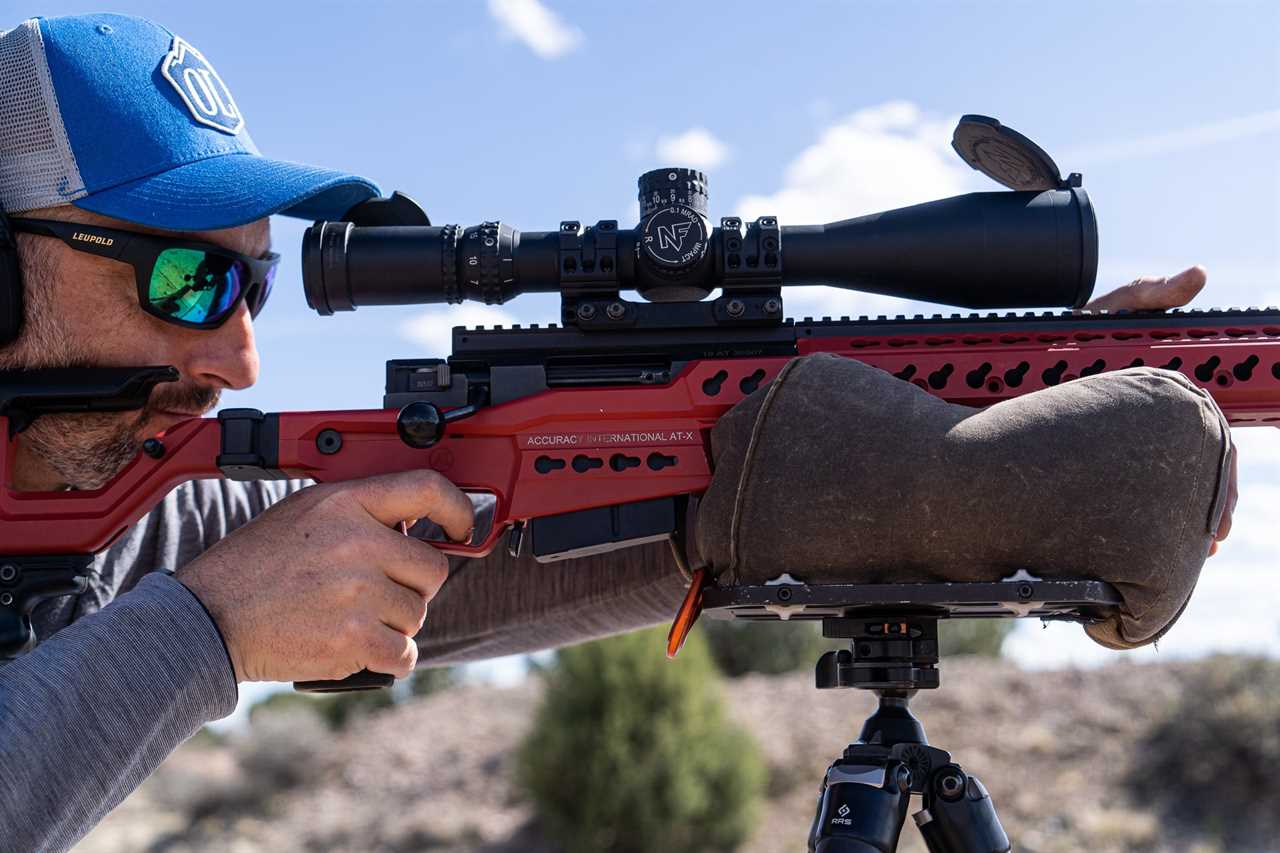
John Snow runs the AI AT-X from a tripod. Natalie Krebs
The two-stage trigger is remarkable and provides outstanding control. The trigger on our rifle broke at 10.4 ounces, has a flat face and is adjustable for trigger reach, one of the many dimensions that the shooter can alter for a custom fit. (The rifle also comes with a heavier spring for the trigger that will set the minimum break weight to 1.5 pounds.)
The stock as you might imagine can be altered every which way as well. The length of pull, comb height, comb orientation, and recoil pad position all adjust. LOP and cheek hardware are secured by allen-key bolts while the recoil pad adjusts with a single wheel that the shooter can tweak on the fly.
The rifle runs off AI AW magazines, which are compact 10-round double-stack magazines that are easy to load, even through the ejection port with the magazine in place.
This short (and incomplete) list of features doesn’t really capture the essence of what makes the AT-X special, however. Of course, there’s the rifle’s accuracy, which was far and away the best of the test. The average 5-shot group measured .456 inches, which is outstanding for factory ammunition. But beyond this was how well the rifle handled. The AT-X is so steady and responsive that only the most insensible clod could fail to shoot better when running it.
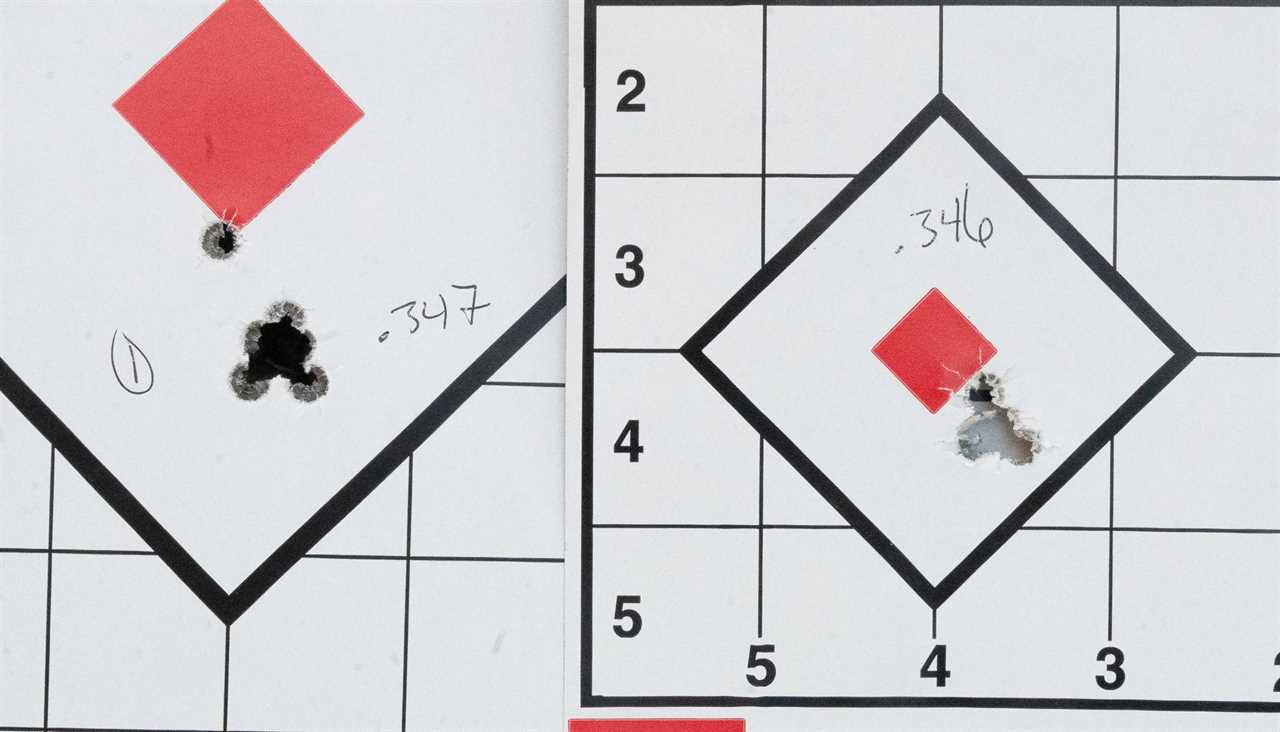
The AI AT-X was the most accurate rifle of the 2022 test field. Natalie Krebs
The rifle delivers exceptional feedback. All the members of the test team commented on this quality. Even when shooting tiny groups, which the AT-X does at will, it was easy to call our shots when the trigger broke. The bullet holes appeared exactly where you expected them to. The AT-X inspires confidence.
Perhaps the only thing we didn’t care for was what isn’t included in the base $4,995 price. You don’t get any of the proprietary Picatinny rail sections (and an ability to attach a sling to the front of the stock). Nor does the stock fold. It would also be a benefit if the various fasteners all used the same size Allen-key. As it stands now, you need a small tool kit to service the rifle.
These critiques aside, the AI AT-X wooed the entire test team and sets a new standard for what a factory rifle can deliver.
Great Buy and Most Innovative Rifle of 2022, Precision: Seekins Precision Havak HIT
Report Card
- Performance: Very good
- Design: Very good
- Value: Excellent
Seekins Precision Havak HIT Specs
- Action: Two-lug bolt
- Stock: Folding aluminum chassis
- Caliber: 6.5 PRC
- Capacity: 5-round AICS magazine
- Weight : 11.5 pounds
- Trigger: 2 pounds 8 ounces, adjustable
- Barrel: 24 inches, threaded 5/8-24
- Length: 43.5 inches
- Price: $2,100
At the risk of venturing into dad-joke territory, HIT is an apt name for this rifle because it is an unqualified homerun for Seekins Precision. We’ve come to expect good things from Glen Seekins, but even when stacked against our lofty expectations, this new, innovative, accurate, versatile, and fun rifle blew us away.
Let’s examine each of those qualities in turn.
Some guns are newer than others. Some are built on pre-existing parts shared across different companies. Not the HIT. Except for the trigger, this rifle is entirely of Seekins’ design and the chassis and barrel change system are new as of late last year.
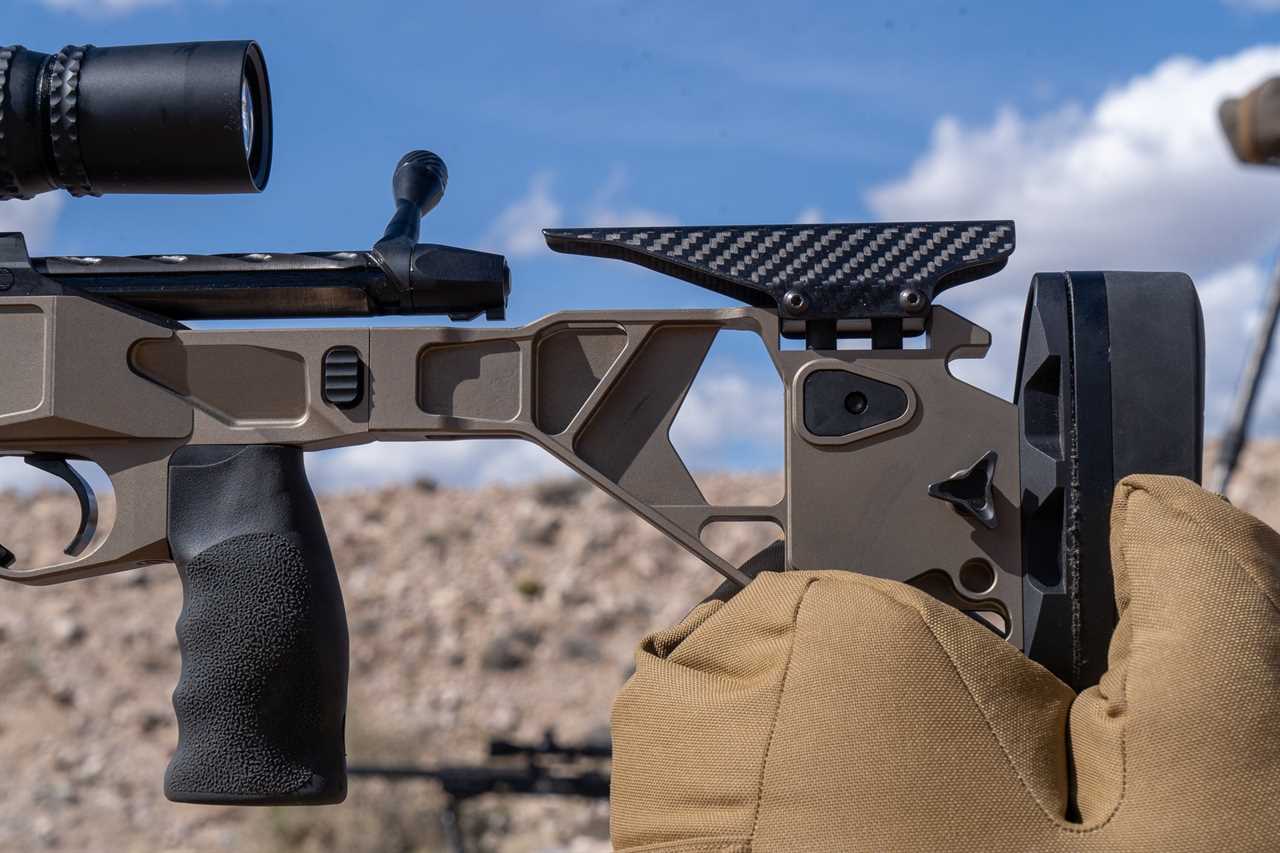
The Seekins stock is brilliantly designed. Natalie Krebs
There are a lot of innovations stacked in this rifle. To change the barrel, for example, all that’s needed is for the shooter to loosen an easily accessible set screw positioned at the base of the forward edge of the Picatinny rail and then unscrew the barrel from the receiver. Changing to a cartridge with a different sized bolt face is simply a matter of removing the bolt from the action and swapping bolt heads, a process that takes about a minute.
With the proliferation of precision rifles, there’s no shortage of chassis on the market, and many gun makers have gone to after-market suppliers. Some of those chassis are very good (and expensive) and others are just okay, but affordable. It’s a roll of the dice for any gun maker to build their own, but the gamble paid off for Glen. Not only is his folding-stock design excellent, but by keeping those costs in-house he’s able to offer the HIT at an incredible price, which is why this rifle was a unanimous Great Buy pick.
The ultimate yardstick by which any precision rifle is judged is its accuracy. The Seekins Havak HIT makes the grade with room to spare. It was second in accuracy only to the Accuracy International AT-X, but even that doesn’t really reflect the rifle’s performance as the AI had a couple advantages over the Seekins. Specifically, the AI was run with an optional weight system installed that boosted its scoped weight to nearly 20 pounds versus the 14-pound, 2-ounce weight of the Seekins with its scope. Next, the Seekins was chambered in 6.5 PRC as opposed to the 6.5 Creed in the AI. With more factory loads to pick from, a rifle in 6.5 Creed will have an easier time finding more accurate ammunition, plus there’s the minor (but not negligible) disparity in the relative recoil of the two cartridges.
So that makes the average 5-shot group size of the Seekins—.542 inches—all the more impressive. It shot Hornady 147-grain ELD-M bullets especially well, with several sub-.5 MOA groups. But it also turned in excellent results with Federal’s 130-grain Terminal Ascent and Hornady’s 143-grain ELD-X, both of which are very effective long-range hunting bullets, with numerous groups between .5 and .6 inches from each.
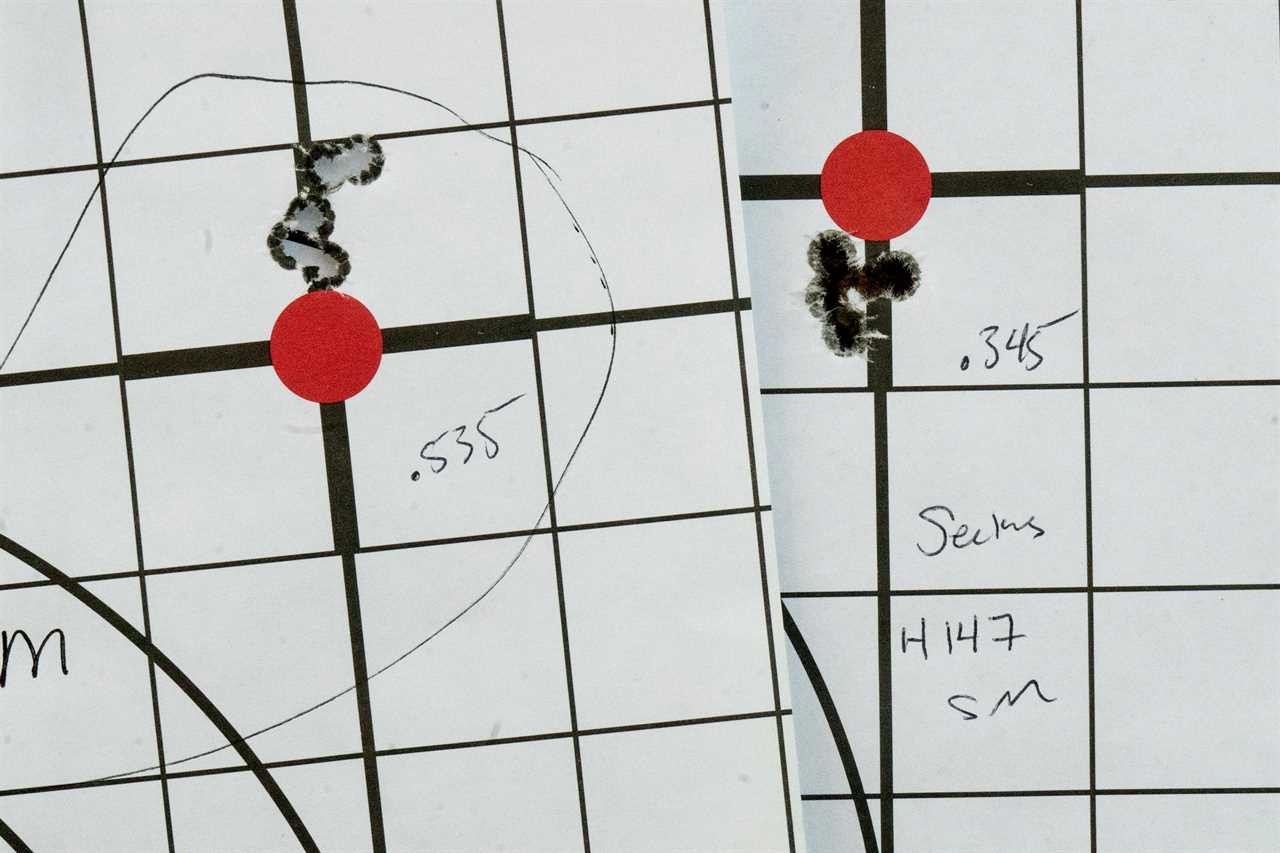
Some of our better five-shot groups with the Seekins. Natalie Krebs
That speaks in part to the versatility of the rifle, which wowed the judges as well. Down the road we’ll probably see carbon-fiber barrels for the HIT, which will drop it’s 11.5-pound weight to something that’s more in keeping with standard big-game rifles. With its folding stock, it can be stashed within a pack making it a viable option for hunters on the move. Conversely, there are numerous attachment points to add weight to configure it for precision rifle competitions where 20-pound guns are the norm.
The current list of available drop-in barrels includes 6mm GT, 6mm Creedmoor, 6.5 Creedmoor, 6.5 PRC, and .308 Win. The 6s and 6.5s barrels all have 1:8 twists, while the .308 is 1:11.25.
For a bunch of gun nerds like the Outdoor Life test team this adds up to a rifle that is a blast to run. The rifle is responsive, well-balanced and has great ergonomics. None of the rifles in this year’s test posted such high scores across the board, which is what drove it to an impressive (and rare) double award win.
Great Buy, Hunting Rifle: CZ-USA 600 Alpha
Report Card
- Performance: Very good
- Design: Good
- Value: Excellent
CZ-600 Alpha Specs
- Action: Three-lug bolt
- Stock: Synthetic
- Caliber: 6 CM
- Capacity: 5-round detachable box magazine
- Weight : 7 pounds 10 ouunces
- Trigger: 1 pound 11 ounces, adjustable
- Barrel: 22 inches, threaded 5/8-24
- Length: 42.2 inches
- Price: $749
The 600 series is the future of CZ’s centerfire rifles. Introduced in late 2021, this platform replaces the previous actions, which while beloved, were comparatively complicated to produce and out of step with more modern firearms manufacturing that favors modular platforms. (Read our full review on the 600 Alpha introduction here).
That modularity was evident with the product launch. CZ kicked off the 600-era with four distinct configurations creating rifles with vastly different missions.
The Alpha is the base model, the economy version if you will, and while the other 600s might have fancier stocks and more tricked out features, none of them can match the Alpha for pure value. In fact, none of the other new rifles could match the Alpha in value either, which is why it won this year’s Great Buy award by a comfortable margin.
The Alpha is a solid, all-around big-game rifle that won’t break the bank. And it is built in such a way that it will happily do just about anything you ask of it. It would be perfectly at home in a deer camp, hanging in the rear-window rack of a pickup, taking a bead on a prairie dog, or just punching holes in paper.
It was more accurate than a number of rifles costing twice as much (or more). The average 5-shot group from the Alpha measured .814 inches, with a number of groups measuring less than .75 inches.
Our sample was chambered in 6mm Creedmoor. Among the different types of factory ammo we shot, the CZ did well with Nosler’s 105-grain RDF, Hornady’s 108-brain ELD-M, and the Berger 105-grain Hybrid.
The 600 series has a couple interesting innovations built into it, including one of the better, and more idiot-proof, adjustable triggers we’ve ever seen. The adjustment screw is located right in front of the trigger and has four easy-to-see settings you can choose from. At the lightest setting, ours trigger pull was a sweet 1 pound, 11 ounces.
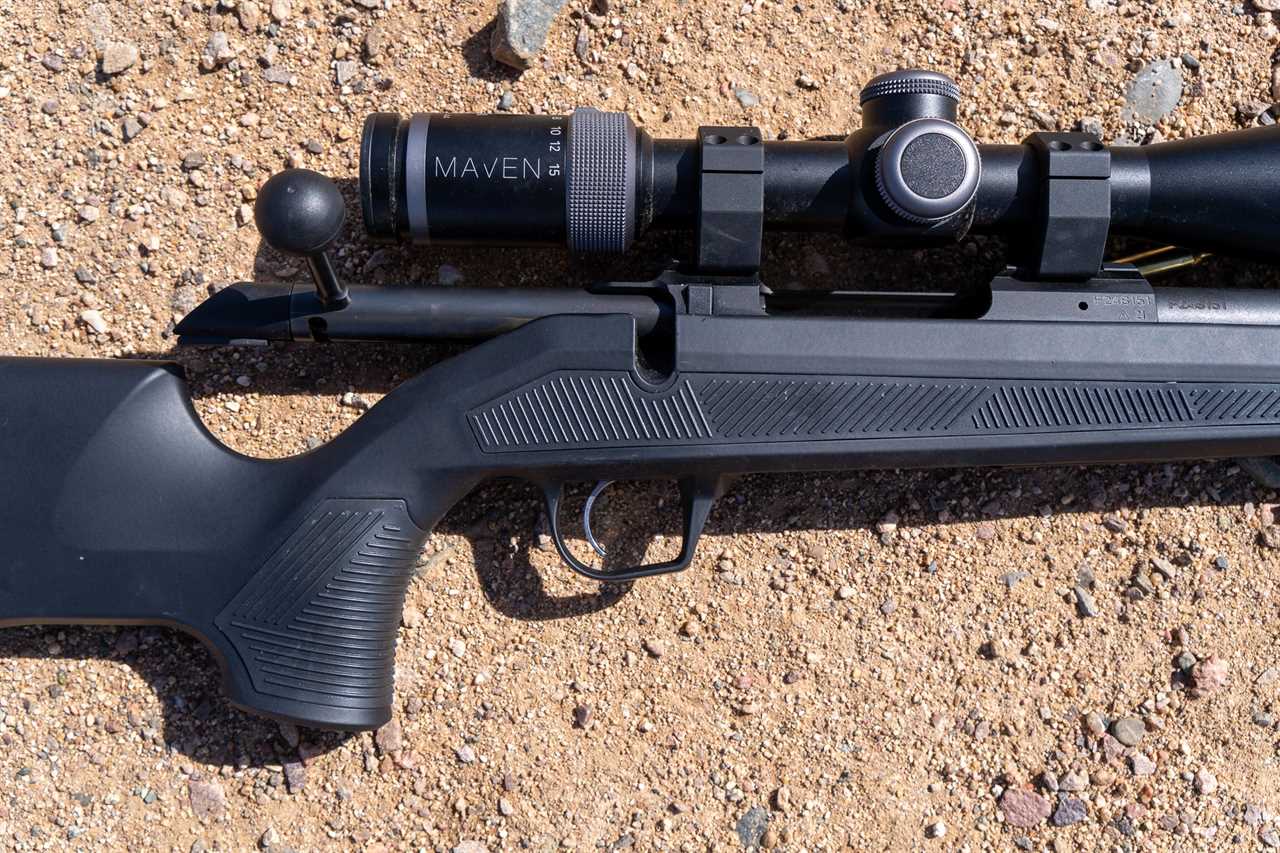
Testers loved the stock design of the CZ 600 Alpha. Natalie Krebs
It also has a curious safety that is a crossbolt that runs vertically through the grip, with the top just behind the bolt shroud and the bottom located just behind the trigger guard. Pushing down on the plunger puts the rifle in “fire” mode and with the safety up the bolt locks into position, which is a useful feature on a hunting rifle. You can still open the bolt with the rifle on safe by depressing the ergonomic bolt release tab just aft of the ejection port. With a little practice the safety becomes intuitive to manipulate.
The detachable box magazine sits nearly flush with the stock and because it has a double-stack design, it’s able to hold 5 rounds. To insert the magazine correctly you need to rock in place pushing on the rear of the magazine first. The fact that you can’t just push the magazine straight in and have it seat home irritated some of the judges. Removing the magazine requires no similar digital manipulation. A push on the slightly recessed mag release in front of the mag well will pop the magazine free.
The Alpha has two rail sections on the receiver for mounting a scope, another nice value-added element. The barrel is threaded for suppressors and the like. If you’ve read about the CZ-600 before, no doubt you heard about its switch-barrel capability. Unfortunately, CZ has had to walk back on that feature. Going forward, all 600s will have their barrel permanently affix in place and they’ve issued a recall for the 600s they shipped out prior. You can read about the issue here. I know they are looking at ways to reincorporate this feature down the road, and I hope they do, because it is another cool feature of the platform.
Proof Tundra
Report Card
- Performance: Very good
- Design: Very good
- Value: Fair
Proof Tundra Specs
- Action: Two-lug bolt
- Stock: Carbon-fiber composite
- Caliber: 6.5 CM
- Capacity: 5-round hinged floor plate magazine
- Weight : 7 pounds 2 ounces
- Trigger: 2 pounds 10 ounces, adjustable
- Barrel: 24 inches, carbon fiber threaded 5/8-24
- Length: 43 5/8 inches
- Price: $7,699
The Proof Tundra is an undeniably sexy rifle with a price tag to match. It is more than just a pretty face, however—it’s a shooter. The two most accurate rifles of the test were the Accuracy International AT-X and the Seekins Precision Havak HIT—both heavy-barreled precision rifles—but the Proof Tundra nipped at their heels with an average 5-shot group size of .683 inches making it the most accurate hunting rifle of the evaluation.
Chambered in 6.5 Creedmoor it shot its best groups with 140-grain loads. All but two of the top 10 five-shot groups were with 140s from Federal, Nosler, and Hornady.
That accuracy takes some of the sting out of the $7,699 cost, but what else does the Tundra offer to motivate a hunter looking to spend the kids’ inheritance? A couple things come to mind. First, is the Tundra’s excellent balance. At 7 pounds, 2 ounces it hits a sweet-spot for a versatile big-game rifle. It handles nimbly from practical field positions with a lively, capable feel. It came quickly to shoulder and cycled well. Some testers felt the trigger reach was a bit excessive for their tastes, but other than that no one had any issues with the rifle’s function.
The fit and finish is one area where the Tundra really shines. The inletting between the stock and action is perfect and upon close inspection it is easy to see the level of craftsmanship that went into the Tundra, elevating it above the other high-priced hunting rifles in the test. The perfectly flush line where the stock and ejection port meet is one example.
The adjustable cheek piece on the stock is a useful feature and well executed. Often, adding an adjustable comb comes with a significant increase in weight, but Proof’s design is light and allows for quick in-field adjustments.
The team was split on the stock’s finish. Some of us liked the snake-scale pattern, which added a bit of texture for a secure handhold, others thought it looked too much like fishnet stockings for their taste. Given that Proof offers the rifle in a number of finishes, including custom paint jobs, this isn’t likely to dissuade a potential buyer.
In addition to the 6.5 Creedmoor, the Tundra comes chambered in 6 Creed, 6.5 PRC, 7mm Rem. Mag., 28 Nosler, .308 Win., .300 Win. Mag., .300 PRC, and for those who just can’t have enough recoil, the .300 RUM, and .338 Lapua.
Christensen Arms Ridgeline Scout
Report Card
- Performance: Very good
- Design: Very good
- Value: Very good
Christensen Arms Ridgeline Scout Specs
- Action: Two-lug bolt
- Stock: Carbon-fiber composite
- Caliber 6.5 CM
- Capacity: 10-round AICS magazine
- Weight : 5 pounds 14 ounces
- Trigger: 2 pounds 1 ounce, adjustable
- Barrel: 16 inches, carbon fiber threaded 5/8-24 with flash hider
- Length: 37.5 inches
- Price: $2,199
Christensen Arms has been one of the most exciting gun makers in recent years. They’ve been on a roll of late and it looks like for 2022 they have another winner with the Ridgeline Scout (read our full review on the Ridgeline Scout here).
The Scout comes with a 16-inch carbon-fiber barrel that is threaded and ships with a cool-looking (but superfluous) three-pronged flash hider. The short barrel is one of the key elements of the Scout-rifle concept. Also in keeping with the Scout vibe, the Christensen Arms is fed by a detachable box magazine (an AICS pattern) and is sub-6 pounds at 5 pounds, 14 ounces.
Scout rifles are meant to be handy general-purpose rifles that can work for hunting, personal protection or any other rifle-related chores and the jack-of-all-trades versatility of the Ridgeline Scout was immediately evident to all the gun test judges.
We could see it as a mountain rifle for sheep in Alaska, as a handy tree-stand deer rifle in the Midwest, as a suppressed hog gun in Texas, as a walking varmint rifle, and even as a viable option for the NRL Hunter competition series.
The rifle’s good accuracy helps inspire this confidence in its potential. It averaged .784 inches, with a number of five-shot groups smaller than .6 inches. The rifle can be had in five chamberings: 6.5 Creedmoor, which was what we tested, .300 BLK, .223 Rem., .308 Win., and 6mm ARC.
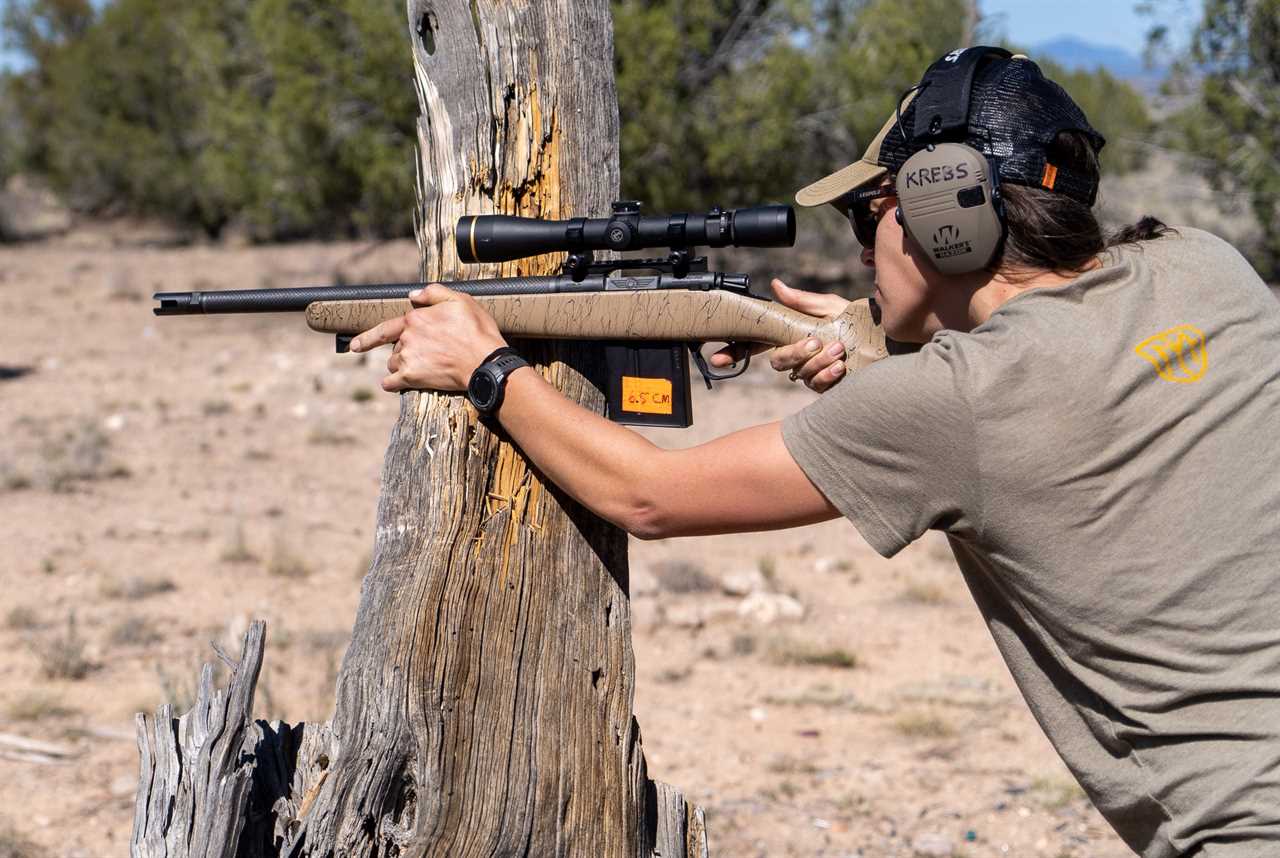
The nimble Christensen Ridgeline Scout was our favorite gun to run through the Scrambler. Alex Robinson
Universally, we found the rifle fun to shoot. We ran it several times through the Gunsite Academy Scrambler, where its virtues really shone. The oversized bolt handle made cycling the action a snap and even with a suppressor attached, the rifle’s balance and dynamic handling was excellent.
The rifle comes with a short section of Picatinny rail on the fore-end that incorporates a barricade block and serves as a mounting point for a bipod. The stock is carbon fiber and has stainless steel bedding pillars, and is stiff, strong and comfortable. The black nitride finish keeps the action running smoothly, but we did need to clean the rifle occasionally to keep the bolt lift from getting gummy.
The only misstep with the rifle’s configuration is the flat-faced trigger. The trigger itself, a TriggerTech, is excellent, but the flat face doesn’t work with the stock’s geometry. The trigger finger ends up bearing unevenly on the trigger face because of the curved radius of the stock’s grip. A normal curved trigger would work better.
But that didn’t prevent us from shooting the Ridgeline Scout nearly nonstop during the week-long evaluation. Even at $2,199 we thought it a wonderful value and and a strong choice for a do-it-all rifle.
Marlin 1895 SBL
Report Card
- Performance: Very good
- Design: Very good
- Value: Very good
Marlin 1895 SBL Specs
- Action: Lever
- Stock: Laminate
- Caliber: .45/70 Government
- Capacity: 6+1
- Weight : 7 pounds 4 ounces
- Trigger: 6 pounds 7 ounces
- Barrel: 19 inches, stainless threaded 11/16-24
- Length: 37 1/4 inches
- Price: $1,399
The reintroduced Marlin 1895 SBL, now being produced by Ruger at its Mayodan, North Carolina, factory has garnered a lot of attention, and for good reason. Not only has Ruger rescued the beloved Marlin brand from the brink of destruction, but it’s making the finest production Marlin lever guns ever (read our full review on the Marlin 1895 SBL here).
The 1895 SBL was Marlin’s first model to go into production following the acquisition of the company by Ruger. It is an appealing configuration, a short-barreled .45/70 in stainless steel stocked with an attractive gray laminate stock and equipped with an oversized lever loop and an XS Sights rail and ghost ring sight set.
We removed the ghost ring sight in order to mount a Leupold Mark 6 1-6×20, which is an ideal optic for the platform, allowing for close-up fast shooting while be able to reach out for the longer shots that the 1895 SBL is capable of making.
The 1895 cycles through the six rounds it can hold quickly, and did so in a reliable, consistent manner. The precise-fitting CNC-machined and EDM-cut components eliminate the slop that can bedevil some lever guns and make them hang up.
The average 5-shot group from the Marlin came in at 1.66 inches. Hornady’s 325-grain FTX load delivered the best accuracy with groups that averaged 1.28 inches. With that kind of performance, you can really reach out despite the .45/70’s rainbow trajectory. With the right elevation and windage hold, the Marlin is capable to 300 yards.
But its happy place is shooting that’s up close and personal. Once we got done with the accuracy portion of the evaluation, we were able to let loose and give the steel targets at Gunsite a proper workout with the heavy .45/70 slugs. The rifle’s 7-pound, 4-ounce heft, broad recoil pad, hand-filling fore-end, and polished lever loop make it comfortable to shoot even with stout loads.
The fit and finish of the stock and metalwork is a step above the Marlins of old. The checkering is the best I’ve seen on any modern Marlin production gun, while the engraving on the metal is tasteful and attractive. By any yardstick, Marlin is back and its prospects are brighter than ever.
Weatherby Mark V Backcountry 2.0 Ti Carbon
Report Card
- Performance: Very good
- Design: Very good
- Value: Good
Weatherby Backcountry 2.0 Ti Carbon Specs
- Action: Six-lug Bolt (Two rows of three)
- Stock: Carbon-fiber Composite
- Caliber: 6.5 CM
- Capacity: 4+1
- Weight: 5 pounds 2 ounces
- Trigger: 3 pounds 4 ounces, adjustable
- Barrel: 24 inches, carbon fiber threaded 5/8-24
- Length: 36 1/2 inches
- Price: $3,850
We were fans of the original Backcountry from Weatherby, and the new 2.0 version is a smart evolution of the model. It comes in four different configurations, and we tested the flagship offering, which has a carbon fiber barrel and titanium receiver.
This is a true mountain rifle. Tipping the scales at a scant 5 pounds, 2 ounces, it is just what you want for a high-altitude hunt where you’re cutting the tags out of your underwear to save weight. That figure is especially impressive given that the rifle comes with a 24-inch barrel.
For such a light rifle, the accuracy was quite good. The 5-shot average of the best 10 groups was .824 inches. The rifle’s accuracy was remarkably consistent across different brands and weights of bullets, though, like many of the other 6.5 Creedmoors in the test, it favored the 140-grain projectiles.
The rifle tended to heat up quickly—not surprisingly—and we did note that often the fifth shot in a string would open up the group quite a bit. Point being, in a real-world hunting situation you can expect the rifle to deliver excellent accuracy for the first trigger pulls.
A bunch of the weight savings comes from the titanium receiver, a material that’s becoming more common in rifles with each passing year. The biggest knock on titanium is that it isn’t nearly as slick as steel, and titanium actions tend to stick and hang up. The Mark V action did this a bit, but not as much as other titanium actions I’ve used in the past and as we put more rounds through the rifle it seemed to smooth out some. Regular cleaning and drop or two of oil helps mitigate this as well.
The 6-lug action has Weatherby’s short 54-degree bolt throw and is a pleasure to run. We didn’t have any functionality issues during the test and the rifle digested everything we put through it.
The innovative recoil pad has been updated from the first-generation Backcountry. It has a similar 3-D printed construction, but the pad is not nearly as squishy and doesn’t take a set when the rifle is resting on it.
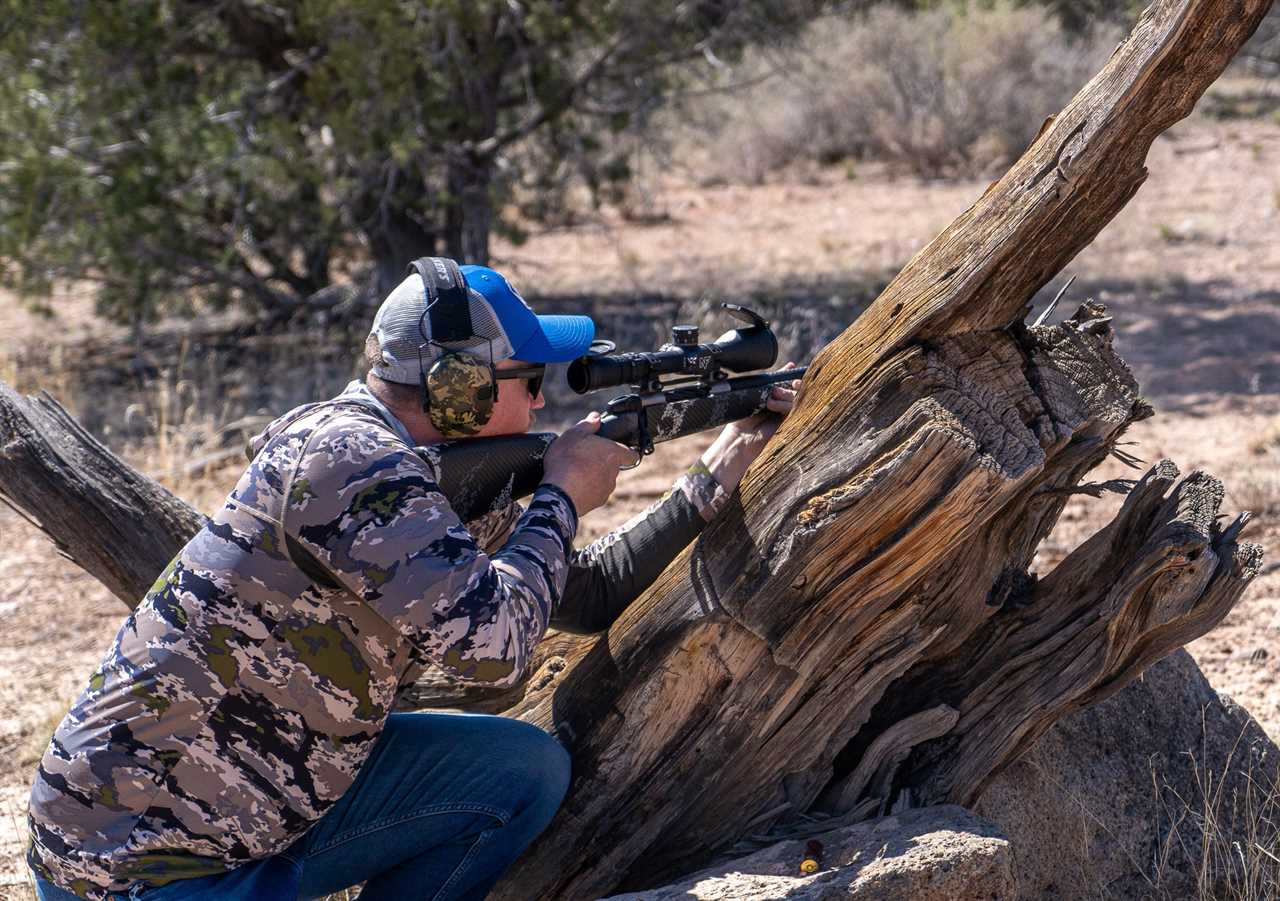
The Weatherby Backcountry 2.0 Ti Carbon is a light and handy mountain rifle. Natalie Krebs
From an aesthetic standpoint, we felt the rifle could use some improvement, particularly in light of its nearly $4,000 price tag. The fit and finish of the stock wasn’t as sharp as we would have liked and where the top of the grip blends into the tang of the action showed some clumsy file work on our sample. It’s also probably time for Weatherby to update their Mark V safety as well. The folded tab of metal is functional but not very elegant and seems out of place on a modern premium rifle.
One great thing the Backcountry series has going for it is options. The rifles can be had with either steel or titanium actions, and steel or carbon-fiber barrels. On top of that, Weatherby is very lefty-friendly. In the 2.0 Ti Carbon, for example, the rifles are available in .257 Wby., .300 Wby., 6.5 Creedmoor, 6.5-300 Wby., and 6.5 Wby. RPM. Of those, left-handed actions can be had in the .257, .300 and 6.5-300.
Other variants of the Backcountry 2.0 are available in other calibers, both right- and left-handed as well. And while none of them are cheap—the base model with steel receiver and steel barrel starts at $2,699—any hunter looking for a rugged, accurate mountain rifle will be able to find something that suits their needs.
B&T SPR300 Pro
Report Card
- Performance: Very good
- Design: Very good
- Value: Good
B&T SPR300 PRO Specs
- Action: Two-lug bolt
- Stock: Folding Aluminum Chassis
- Caliber: .300 BLK
- Capacity: 10-round AR-15 style magazine
- Weight : 8.5 pounds
- Trigger: 3 pounds, adjustable
- Barrel: 9.8 inches, included suppressor
- Length: 39.7 inches
- Price: $5,200
Look, guns are serious. This is a serious review of the best rifles of 2022. And the B&T SPR300 Pro is undeniably a serious gun designed for professionals doing serious work. That said, this firearm does an incredible job of turning gunpowder into smiles.
The B&T SPR300 Pro is a takedown rifle with a short, 9.8-inch barrel that is encased in a long suppressor that’s designed for sub-sonic .300 Blackout loads. With its folding stock it stows away in a very discreet case and makes a Hollywood-quiet pffft sound when you pull the trigger. It’s also remarkably accurate in a cartridge that isn’t known for superior accuracy.
In other words, it is exactly the kind of rifle that Jason Bourne, or his real-world counterparts, would take into an urban environment. And while you or I will never be called upon to take out the head of a global terrorist cell strolling across some bridge in Prague, you can justify the $5,200 price of this rifle with the knowledge that you possess the ultimate suburban whitetail rig. Or nighttime hog gun. Or maybe you just wanted to go all out for your kid’s first deer gun.
However you rationalize it, it is difficult to overestimate the amount of fun you’ll have watching 220-grain bullets arc downrange, dropping into small clusters on paper or steel 100 yards away. With your scope’s power dialed back far enough to provide a good field of view you can watch the whole show through your optic. What price can you put on such entertainment?
The barrel’s 1-in-8 twist stabilized the 220-grain .300 Blackout bullets well enough to deliver an average accuracy of 1.036 for 5-shot groups. Both Sig Sauer’s and Black Hills Ammunition performed well in the rifle. Both loads were essentially interchangeable and remarkably consistent with the spread between the best ten groups going from .843 to 1.2 inches. The 200-grain load we ran through the rifle shot 1.5 inches on average and the 125-grain OTM bullets grouped consistently at 2 inches.
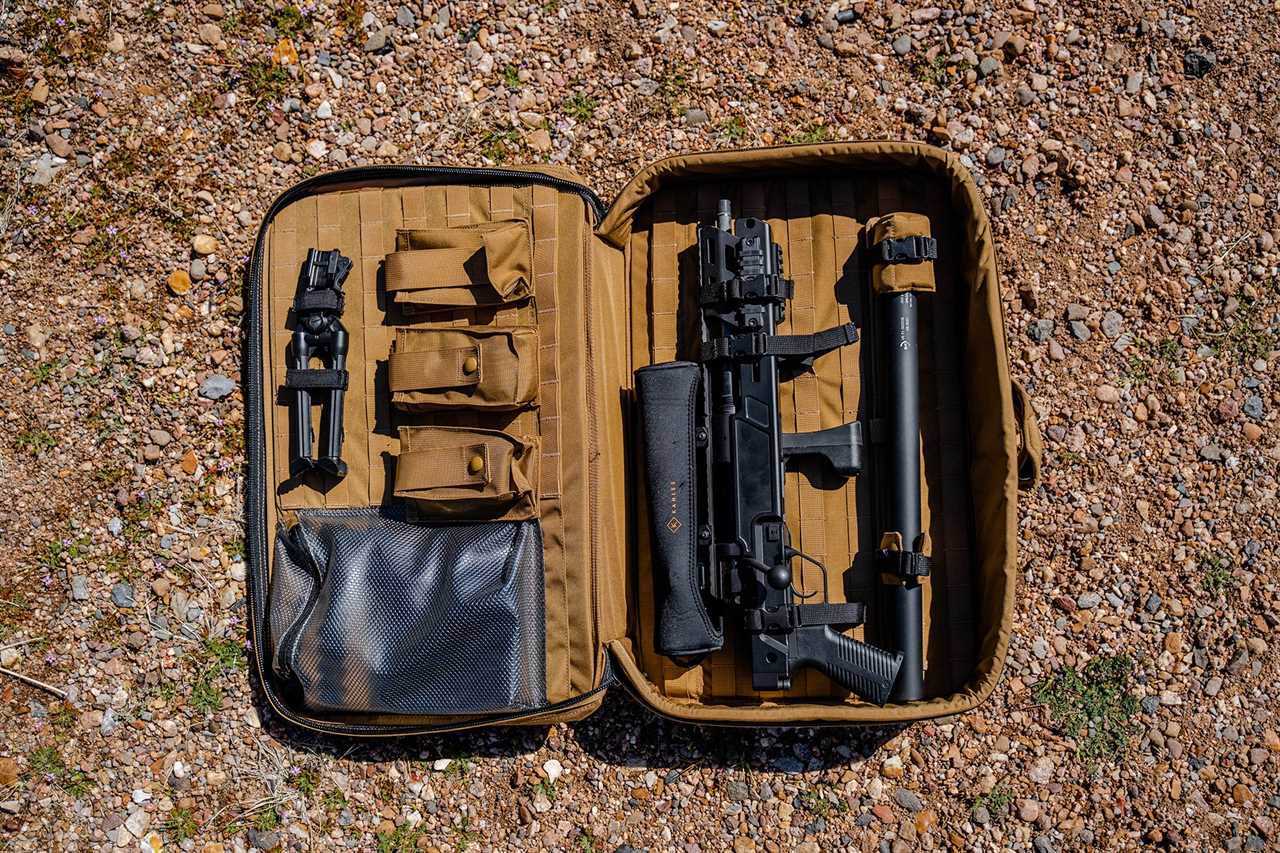
The B&T SPR300 Pro fits into a compact case. Tanner Denton
It’s worth mentioning that the rifle kit includes two cases (one hard, and one soft that goes inside the hard case—both of them of good quality), a bipod, and scope rings. The clear-sided polymer magazine is a standard AR-15 pattern, so you won’t have any issues finding extra mags for the rig.
CVA Cascade SB
Report Card
- Performance: Good
- Design: Good
- Value: Very good
CVA Cascade SB Specs
- Action: Two-lug bolt
- Stock: Synthetic
- Caliber: 6.5 CM
- Capacity: 4-round detachable box magazine
- Weight : 6 pounds 15 ounces
- Trigger: 2 pounds 7 ounces
- Barrel: 18 inches, threaded 5/8-24
- Length: 38.5 inches
- Price: $670
CVA’s newest offering in the Cascade family has an 18-inch barrel (the SB stands for short barrel) and was designed for hunters who use suppressors and operate out of ground blinds and in tree stands.
We found the Cascade SB a fun little gun at a good price. At $670 it was the most budget-friendly of the year’s new rifles. The three-lug bolt-action ran with snappy assurance and while the rifle isn’t going to win any beauty contests, we liked its rugged, stubby, and utilitarian appearance. If for some reason you were inclined to treat it as a safe queen, don’t. It has a strong truck-gun vibe.
At the range it turned in a middle-of-the-pack accuracy average of 1.070 inches, which is more of a commentary on how good today’s rifles shoot than it is on the performance of the CVA. The plastic detachable-box magazine functioned well and was easy to load, insert, and remove from the gun. The receiver is topped with two short Picatinny rail sections for mounting optics, augmenting the rifle’s value.
The stock has a tacky coating and panels of diamond-shaped checkering on the fore-end and around the grip for a very secure hand hold. Moderate palm swells on either side of the grip are a nice touch too. The stock comes with dual swivel studs up front and one on the buttstock.
The one thing we found annoying about the rifle was the CVA sticker on the bottom of the fore-end. Stickers of this type are ubiquitous. Gun makers employ them so their wares have a chance of standing out among the sea of black stocks on your gun dealer’s shelves. But usually the stickers peel off easily. Not the Cascade SB’s. It was as tenacious as the impound stickers placed on car windows by big-city police departments and to this day we’ve only managed to remove about a third of it from the stock.
CVA is offering the Cascade in 6.5 Creedmoor, which we tested, .308 Win., and in .300 Blackout with a 16.5-inch barrel for an even more compact profile. In all cases the barrels are threaded 5/8-24 at the muzzle.
Benelli Lupo Limited Edition
Report Card
- Performance: Good
- Design: Good
- Value: Fair
Benelli Lupo Limited Edition Specs
- Action: Three-lug bolt
- Stock: Walnut
- Caliber: 6.5 CM
- Capacity: 5-round detachable box magazine.
- Weight : 7 pounds 6 ounces
- Trigger: 2 pounces 8 ounces
- Barrel: 24 inches, threaded
- Length: 44 5/8 inches
- Price $2,199
This upgraded Benelli Lupo, called the “Limited Edition,” is a quirky and charming rifle. The “Limited” refers to the upgraded wood and metal finishes that give the rifle a more sophisticated and European air compared to initial Lupo that Benelli introduced in 2020.
Before delving into the rifle’s aesthetics, which are a bit of mixed bag, let’s talk about the rifle’s handling, which the test team unanimously praised.
Even though the Lupo has made some inroads with American hunters, it was designed with European shooters in mind. While it can handle a variety of hunting scenarios, driven hunts and shooting from elevated stands are its happy place.
The stock geometry, slick three-lug action and protruding bolt handle favor nimble handling for shots at running game. And during our evaluation, it was dynamic shooting scenarios where the Lupo excelled. We loved running it off-hand and from kneeling positions while moving between shots. The relation of the shooter’s trigger finger to the trigger is spot-on, and the deep radius of the grip, with its slight palm swell, in conjunction with the trim angles of the fore-end make for superior handling. The two-position safety, located on what would be the tang if the Lupo had one, is extremely positive and comfortable to manipulate.

The Benelli Lupo Limited Edition was a pleasure to shoot offhand and from field positions. Natalie Krebs
Though we didn’t fiddle with it, the Lupo’s stock can be adjusted in numerous ways to customize its fit. By messing with the included shims that fit between the butt stock and receiver and swapping cheek pieces and the length of pull spacer, a shooter can alter all critical dimensions including trigger reach.
Shooting prone, the Lupo was no slouch either. The best 10 five-shot groups averaged .928-inches in our 6.5 Creedmoor. Unlike some of the 6.5 Creeds in the test, the Lupo’s best groups included a variety of bullet weights: 140s, 143s and 147s. It even managed to print a .429-inch group with Winchester’s 140-grain BTHP.
If you count yourself among the 6.5 Creedmoor-haters club, you can get the Lupo in .243 Win., 6 Creed, 6.5 PRC, .270 Win., 7mm Rem. Mag., .308 Win., or .300 Win. Mag.
In terms of appearance, we like the treatment given to the stock to make the wood look fancy. And the look and construction of the detachable box magazine, which sits flush with the angle of the stock and loads easily while offering the cartridges a measure of protection via its double-stack design, is something we appreciated as well.
What we didn’t care for is the bright white lettering on the receiver that says “BE.S.T.” which is an acronym that stands for Benelli Surface Treatment. The treatment itself is fantastic—a combination of Physical Vapor Deposition (PVD) and Plasma Enhanced Chemical Vapor Deposition (PECVD) technologies that create a barrier between the steel and the elements. But the lettering on the lustrous black finish of the barrel is out of place, especially in light of the other colors and textures on the action—brushed metal, a gold “Lupo,” and matte black magazine. If Benelli fixed that, either by blacking out the “BE.S.T.” or, better yet, getting rid of it all together, there would be hardly anything about the rifle to criticize.
CZ-USA 600 Range
Report Card
- Performance: Good
- Design: Good
- Value: Good
CZ-600 Range Specs
- Action: Three-lug bolt
- Stock: Laminate
- Caliber: .308 Win
- Capacity: 5-round detachable box magazine
- Weight : 10 pounds
- Trigger: 1 pounds 7 ounces, adjustable
- Barrel: 24 inches, threaded 5/8-24
- Length: 44.9 inches
- Price: $1,199
We had CZ send us the range along with the Alpha for the evaluation. The Range is geared for long-range shooting from the prone position thanks to its heavy profile barrel and adjustable stock. The action has all the same features as the Alpha described above, except that this rifle doesn’t come with any scope bases.
Our sample was chambered in .308 Win. and while the rifle handled extremely well while shooting prone, we didn’t take a shine to it the way we did with the Alpha. Two issues contributed to this. First, the Alpha was more accurate than its big brother, which took some of the wind out of the Range’s sails. (.814 inch average group versus .941 inches.) Secondly, the Range didn’t cycle with the same flawless assurance of the range. It had weak extraction and didn’t eject empties all the time.
But we did like the geometry of the stock. The fit of the palm swell and the adjustable cheek piece made for very comfortable shooting off our bellies.
Henry Long Ranger Express
Report Card
- Performance: Good
- Design: Good
- Value: Good
Henry Long Ranger Express Specs
- Action: Lever
- Stock: Laminate
- Caliber:.223 Rem.
- Capacity: 5-round detachable box magazine
- Weight: 7 pounds 7 ounces
- Trigger: 5 pounds 4 ounces
- Barrel: 16.5 inches, threaded 5/8-24
- Length: 37 inches
- Price: $1,235
Like most rifle fanatics, I have a big soft spot in my heart for lever guns. And one of the great success stories in this realm is Henry Repeating Arms, which is celebrating its 25th year of production in 2022. One thing I love about this company is that they aren’t afraid to think outside the box and build guns that are just plain fun.
The Long Ranger Express falls into that category. It is a nimble .223 Rem. that’s fed by a detachable-box magazine that can hold 5 rounds of spitzer-style (pointed) bullets. It’s compact (37.75 inches overall) yet has enough heft (just under 7.5 pounds) making it both easy to maneuver in close quarters and shoot accurately off-hand and from other non-supported field positions.
The accuracy with the rifle, which we topped with a 1-6X scope, was pretty good, certainly good enough for deer and coyotes within reasonable ranges. Average five-shot group at 100 yards was 1.29 inches. When we put a higher-magnification optic on it, we got a handful of groups that were under an inch.
We liked the smooth operation of the lever, which cycled all the ammo we put through it without no failures, though the edges of the loop are sharp enough so that your hand will notice. Given that the rifle is designed to take a scope—there are no fixed sights and the receiver is topped with a Picatinny rail—shooters will probably want to add a pad of sorts to the comb so they can have a proper cheek weld when their eye is aligned with the optic.
The muzzle is threaded so you can run the Long Ranger Express with a suppressor. So equipped, it would be an especially-nice deer gun for a new hunter or a truck gun for predators.
Franchi Momentum Elite
Report Card
- Performance: Good
- Design: Fair
- Value: Fair
Franchi Momentum Elite Specs
- Action: Three-lug bolt
- Stock: Synthetic
- Caliber: 6.5 CM
- Capacity: 3-round detachable box magazine
- Weight: 7 pounds
- Trigger: 3 pounds, adjustable
- Barrel: 24 inches, threaded with muzzle brake
- Length: 46.25 inches
- Price: $899
Like many of the other rifles in this year’s roundup, the Franchi Momentum Elite delivered very good accuracy. It’s .887-inch 5-shot group average is solid performance for a sub-$1,000 rifle. Shooting Federal’s 140-grain Sierra Matchking and Nosler’s 140-grain RDFs, it turned in groups just north of a half inch.
Everyone on the team liked the Franchi’s crisp 3-pound trigger and we had good things to say about the 3-lug action’s short bolt throw. These were two big checkmarks in the plus column for this hunting rifle. The rifle ships with a Picatinny rail for easy scope mounting.
But the rifle isn’t without shortcomings. The single-stack magazine, while easy to load, holds a stingy 3 rounds. More concerning was the rifle’s rough chamber, which made extraction and ejection difficult at times. Upon inspection, empty cases from the rifle showed consistent signs of scratches and marring which cleaning the chamber didn’t alleviate.
The camo synthetic stock has integral attachment points for a sling. The benefit of that is that you don’t have annoying swivel studs jutting off the rifle. You can attach a bipod to the stock still, however. There’s a threaded hole that comes with a rubber plug that you can screw a standard swivel stud into for that purpose.
The 24-inch barrel comes with a radial muzzle brake so the rifle’s 7-pound weight doesn’t generate much recoil. Our sample was chambered in 6.5 Creedmoor, but you can get the Momentum Elite in 6.5 PRC, .308 Win., .300 Win. Mag., and .350 Legend.
Savage Impulse Elite Precision
Report Card
- Performance: Good
- Design: Good
- Value: Fair
Savage Impulse Elite Precision Rifle Specs
- Action: Straight pull
- Stock: Aluminum chassis
- Caliber: 6.5 CM
- Capacity: 10-round AICS magazine
- Weight : 11 pounds 15 ounces
- Trigger: 2 pounds 15 ounces, adjustable
- Barrel: 26 inches, threaded with muzzle brake
- Length: 48 3/4 inches
- Price: $2,649
Savage Arms has moved quickly to expand their line of Impulse straight-pull rifles. On the heels of their successful 2021 introduction of this new action in a big-game rifle, they’ve taken aim at the long-range precision world.
The Impulse Elite Precision is stocked with an MDT ACC chassis, which is one of the most popular (and successful) designs in precision rifle competition. It is optimized for positional shooting. Used in conjunction with a shooting bag and bipod, the rifle can be shot off rocks, barricades, tree stumps, 55-gallon drums, tractor tires, and other obstacles while keeping the reticle steady on the target.
The stock is fully adjustable for all critical dimensions, has an ARCA dovetail that extends the full length of the fore-end, has numerous mounting positions for add-on weights to tune the rifle’s balance, comes with a barricade stop in front of the magazine well. It incorporates thumb rests on either side of the grip. The MDT ACC chassis is a top-of-the-line rig.
The action can be set up for right- or left-handed shooters by moving the bolt handle from one side of the bolt body to the other. The action also includes a 20 MOA Picatinny rail and has Savage’s user-adjustable Accu-Trigger.
The Accu-Triggers can be hit or miss in terms of quality, and unfortunately the trigger on our sample was not very good. The amount of grit and creep leading up to the 2-pound 15-ounce break was excessive. Another issue affecting the rifle’s performance is that the action isn’t very smooth. One of the key features of a quality competition rifle is the ability to keep the reticle on target while running the bolt. In theory a straight-pull should do this better than a turn-bolt, but in practice it isn’t so with the Impulse.
The accuracy of our rifle while not bad—it averaged .895 inch 5-shot groups—wasn’t on par with the other precision rifles in the test. As with many of the other 6.5 Creedmoors, it heavily favored 140-grain bullets.
Smith & Wesson Volunteer M&P15 XV-Pro 14.5
Report Card
- Performance: Fair
- Design: Good
- Value: Poor
Smith & Wesson M&P15 Volunteer XV-Pro 14.5 Specs
- Action: Semi-auto
- Stock: Collapsible
- Caliber: 5.56 NATO/.223 Rem.
- Capacity: 30-round magazine
- Weight : 6 pounds 10 ounces
- Trigger: 4 pounds 14 ounces
- Barrel: 14.5, with pinned muzzle brake
- Length: 33.5 inches
- Price: $1,569
This was the only AR-15 rifle submitted for this year’s test. With the Volunteer series, Smith & Wesson is looking to ship well-appointed rifles that are ready for duty or competition right out of the box. This is accomplished by blending their base MSRs with top-notch furniture and accessories.
In the case of this carbine, it comes with a 14.5-inch barrel with a pinned PWS muzzlebrake to push the length to 16-inches to avoid SBR regs. It has Williams Gun Sight Company Folding Sights, a 2-inch section of M-Lok Picatinny rail, a B5 Systems SOPMOD stock, and is set up with a mid-length gas system.
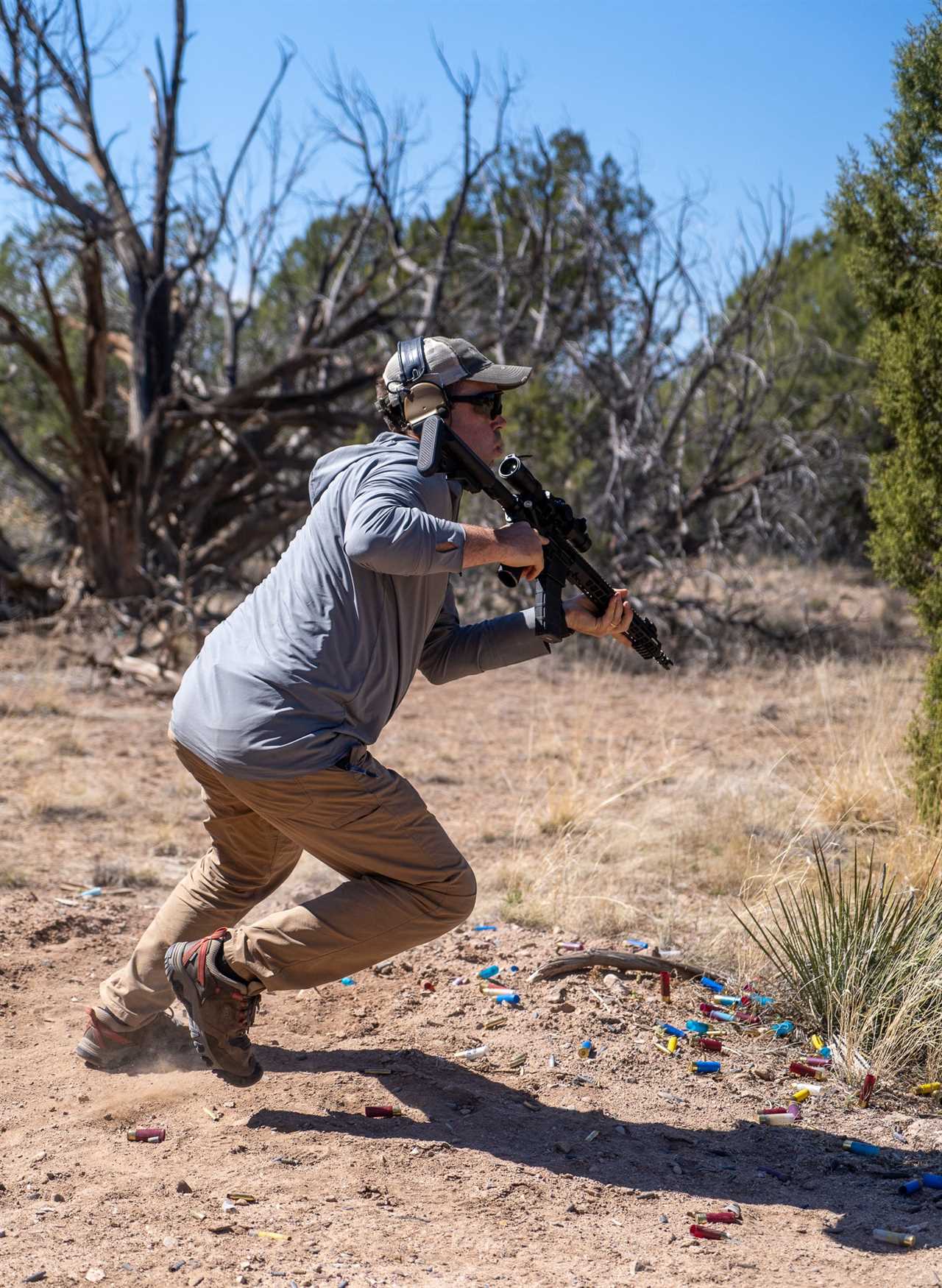
Running the Scrambler at full speed with the Smith & Wesson M&P15 Volunteer XV-Pro 14.5. Natalie Krebs
On paper, it’s a sweet system, and for $1,569 it should be. Unfortunately, this rifle was less than the sum of its parts. While the flat trigger felt nice, it was creepy and at 4-pounds, 14-ounces, too heavy. The safety was very stiff, requiring excessive effort to manipulate. And the accuracy (2.65 inches) was run of the mill. It performed like a typical and basic MSR, not like one costing twice the price.
Notable Trends in the Best Rifles of 2022
With respect to rifle construction and functionality we continue to see more rifles incorporate carbon fiber into their designs, both bringing down weight and helping contribute to rising costs. While not a ubiquitous trend, rifles with switch-barrel systems are becoming more common as well. The Accuracy International AT-X and Seekins Havak HIT, both award winners in this year’s roundup, can change barrels by loosening a single screw.
A less notable, almost imperceptible shift has happened with rifle barrels. I speak of the humble threaded muzzle. It wasn’t so long ago—say 15 years—that relatively few rifles came from the factory with a threaded barrel. Today, nearly all do. In our field of 17, all but one of the rifles were threaded for muzzle devices, including both lever actions. The sole exception was the Smith & Wesson M&P15 XV-Pro 14.5, which is only excluded on a technicality. Its barrel is threaded, but because of the 14.5-inch barrel length, its brake is pinned in place to keep the barrel length over the 16-inch minimum so as not to trigger the BATF short-barreled rifle (SBR) rule. With the rise in practical field-style steel matches and a greater awareness of the risks associated with hearing loss, many shooters and hunters are opting to run suppressors on their rifles, which is part of the reason threaded muzzles have become standard fare.
Best Rifles of 2022: Accuracy Report
We continue to see excellent accuracy from factory rifles shooting factory ammunition. Of the 17 rifles, 11 of them averaged under an inch, which is remarkable given that each rifle did that with 50 shots with varying brands of factory ammo. Three rifles in particular delivered stellar performances. The Accuracy International AT-X lead the way with a .456-inch group average, followed by the Seekins Havak HIT at .524 inches, and the Proof Tundra with a .683-inch average 5-shot group.
What about the rifles that didn’t hit that 1 MOA accuracy mark? Even there the news isn’t bad. Four of those rifles—the two lever actions and the two modern sporting rifles—aren’t really built for that kind of work. And the other two bolt guns shot just over an inch: the CVA Cascade SB (1.07-inch average) and the B&T SPR300 Pro (1.036-inch average).
Excellent Performance from Factory Ammo
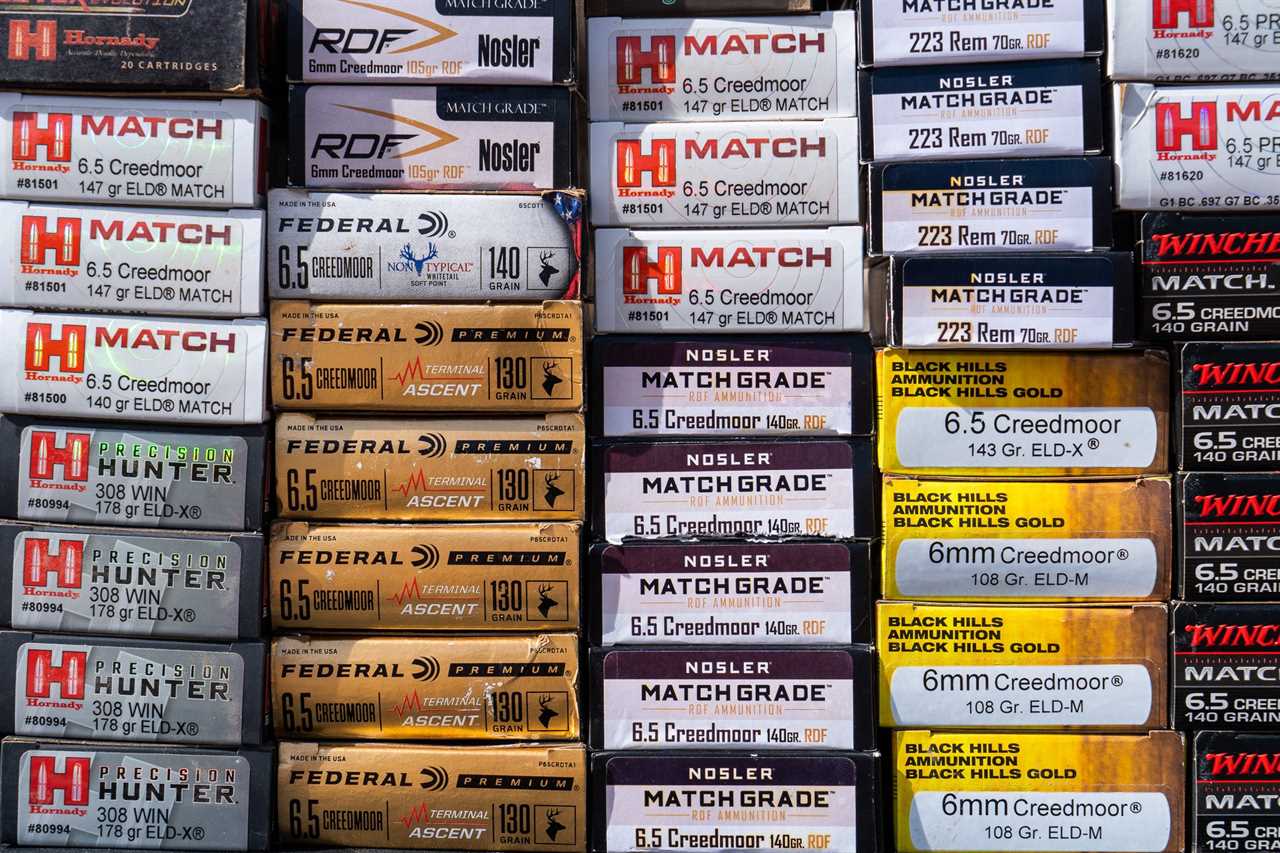
Factory ammo only continues to get better and better. Natalie Krebs
Running a gun test of this magnitude requires a lot of ammo, and in these lean times several companies stepped up to the plate to help us out. Federal, Winchester, Nosler, Hornady and Black Hills Ammunition were all extremely generous with both rifle and handgun ammunition—to the tune of many thousands of rounds. Heck, we put more than 2,000 rounds of 6.5 Creedmoor and 5,000 round of 9mm alone—to say nothing of the other cartridges.
I’m going to break down the performance of the ammunition in another story but two loads in particular are worth mentioning. Federal’s 140-grain SMK and Nosler’s 140-grain RDF. Both delivered stellar accuracy. The average 5-shot group size for the best ten Federal groups was .501 inch, while the Nosler 140 RDF was just a smidge larger at .510 inch. Factory guns shooting factory ammo at that level makes me reconsider all the time I spend handloading for my long-range rifles.
About Gunsite Academy

The OL test team at Gunsite Academy. Tanner Denton
This year’s test was graciously hosted by Gunsite Academy in Paulden, AZ. As the home of the legendary Jeff Cooper and one of the first firearm training facilities that offered classes to the general public, Gunsite became one of the premier gun training destinations in the country.
At Gunsite we got to work with top-line instructors, utilize their excellent ranges and facilities. The existing range setups, number of target stands and faces, an exclusive range, and the genuinely friendly, helpful, and overly-accommodating staff at Gunsite allowed us to conduct our most extensive gun test ever. Even better, you can go do your own training by signing up for a class.
The post The Best Rifles of 2022, Tested and Reviewed appeared first on Outdoor Life.
Articles may contain affiliate links which enable us to share in the revenue of any purchases made.
By: John B. Snow
Title: The Best Rifles of 2022, Tested and Reviewed
Sourced From: www.outdoorlife.com/guns/best-rifles-of-2022/
Published Date: Mon, 24 Apr 2023 19:53:59 +0000
----------------------------------------------
 Backyard GrillingWeekend WarriorsAdvice from DadBeard GroomingTV Shows for Guys4x4 Off-Road CarsMens FashionSports NewsAncient Archeology World NewsPrivacy PolicyTerms And Conditions
Backyard GrillingWeekend WarriorsAdvice from DadBeard GroomingTV Shows for Guys4x4 Off-Road CarsMens FashionSports NewsAncient Archeology World NewsPrivacy PolicyTerms And Conditions
